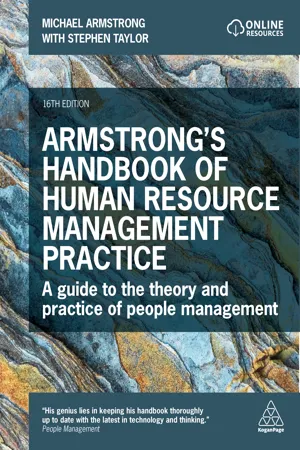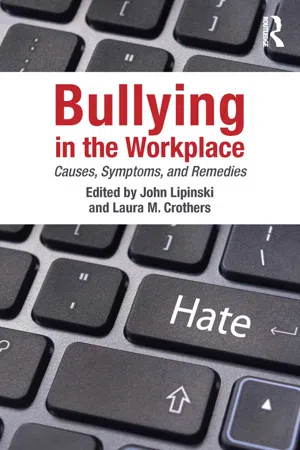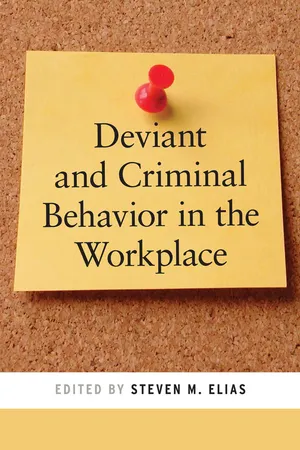Business
Workplace Behavior
Workplace behavior refers to the actions and conduct of employees within a work environment. It encompasses how individuals interact with each other, their work tasks, and the overall organizational culture. Positive workplace behavior contributes to a productive and harmonious work environment, while negative behavior can lead to conflict and decreased morale.
Written by Perlego with AI-assistance
Related key terms
Related key terms
1 of 4
Related key terms
1 of 3
4 Key excerpts on "Workplace Behavior"
- eBook - ePub
Communication in Organizational Environments
Functions, Determinants and Areas of Influence
- Anna Rogala, Sylwester Bialowas(Authors)
- 2016(Publication Date)
- Palgrave Macmillan(Publisher)
2001 , p. 24)))The impact of the factors listed in the above diagram varies in intensity, depending on the situations which a person has to deal with as part of their functioning in a company. A comprehensive analysis of the linkages and relationships between the individual components makes it easier to understand organizational behaviour and its complexity. Moreover, it becomes possible to develop such types of behaviour that are desirable from the point of view of an organization.4.2 Types of Organizational Behaviour
Members of organizations differ from one another, and the behaviours they exhibit may also be different, despite the influence of the same group or system factors. The behaviour of individuals affects the functioning of the organization as a whole, contributing directly or indirectly to achieving the intended goals, or hindering their attainment. This type of behaviour is known as workplace behaviour. In the literature one can find several classifications of organizational behaviour, each adopting a slightly different perspective for analysis.R.W. Griffin and G. Moorhead distinguish the following types of behaviours in the work environment (2009 , pp. 78–79):- performance behaviours, that is, those that an organization expects of its members (good work and efficiency);
- withdrawal behaviours, that is, absenteeism and staff turnover;
- dysfunctional behaviours, which detract from organizational performance;
- organizational citizenship behaviours, that is, a sense of connectedness with an organization which promotes positive contributions to its functioning.
Individuals who display productive behaviours perform their duties well and effectively implement the tasks assigned to them, thus enabling the smooth functioning of the company. Similar effects are produced if employees have a sense of civic connectedness with an organization. In contrast, withdrawal from organizational life, taking the form of frequent absences from work or leaving the organization altogether, makes it difficult and sometimes even impossible to achieve the goals set. Also, dysfunctional behaviours have a negative impact on a company’s operations, which will be discussed in more detail later in this section. - eBook - ePub
Armstrong's Handbook of Human Resource Management Practice
A Guide to the Theory and Practice of People Management
- Michael Armstrong, Stephen Taylor(Authors)
- 2023(Publication Date)
- Kogan Page(Publisher)
17Organizational behaviour
Introduction
Organizational behaviour is the term used to describe how organizations function with regard to their people, structure, processes and culture. It is concerned with the characteristics of people and how they act in organizations, individually or in groups. Organizational behaviour theory is based on the main behavioural science theories, which have been proved by research. Like all proven theories it provides insights into good practice. Thus it produces guidance on the design of organizations, work systems, and jobs and the process of organization development. It also provides the conceptual framework for approaches to achieving the motivation, commitment and engagement of people.An understanding of how organizations function and how people behave in them is important to HR professionals, indeed to all managers, as was emphasized by Nadler and Tushman (1980: 30):Managers perform their jobs within complex social systems called organizations. In many senses, the task of the manager is to influence behaviour in a desired direction, usually towards the accomplishment of a specific task or performance goal. Given this definition of the managerial role, skills in the diagnosis of patterns of organizational behaviour become vital. Specifically, the manager needs to understand the patterns of behaviour that are observed, predict in what direction behaviour will move (particularly in the light of managerial action), and to use this knowledge to control behaviour over the course of time. - eBook - ePub
Bullying in the Workplace
Causes, Symptoms, and Remedies
- John Lipinski, Laura M. Crothers(Authors)
- 2013(Publication Date)
- Routledge(Publisher)
et al. , 2009), specifically, goods of productivity, place (the organization), and persons (see Fritz, forthcoming).Workplace bullying is part of the larger context of an organization's interactive culture (e.g. Salin and Hoel, 2011), a phenomenon situated within the matrix of an organization's interpersonal, structural, and communicative practices. From this perspective, the multifaceted conceptual and operational family of organizational misbehavior is a breeding ground for workplace bullying. Bullying emerges within the context of these problematic behaviors, holding a particular relationship to each term's conceptual framing. In some cases bullying is an element or subcategory of the concept, such as workplace deviance, aggression, or misbehavior. In others, bullying is a parallel phenomenon that is neither subordinate nor identical. Incivility, for example, is a low-level breach of expected interactional norms, but lacks the targeted intensity and power differential characteristic of bullying (e.g. Fritz, 2009). Incivility could, over time, transform into bullying, and bullying may involve incivility as one of its elements (Langan-Fox and Sankey, 2007).In the remainder of the chapter, I review the organizational literature treating counterproductive work behavior, organizational deviance, and workplace aggression as types of organizational misbehavior relevant to bullying in the workplace. Each of these conceptual areas functions as a context within which bullying can be understood as a manifestation, exposing a different facet of the destructive nature of bullying, or as a byproduct, with each construct contributing to the petri dish of a bullying culture. Not only are these behaviors conceptually related – they are practically, phenomenologically, and organically interconnected in their status as creators and sustainers of practices of workplace bullying. Each of these general behavioral themes offers a different way of conceptualizing the harm done by bullies as threats to various “goods” in organizational life (Arnett et al. , 2009). Following Pearson et al. - eBook - ePub
- Steven M. Elias(Author)
- 2013(Publication Date)
- NYU Press(Publisher)
Some of these topics have a long history of interest to HRM scholars (such as theft in the workplace), while others have a much more modern origin (such as organizational citizenship behavior and workplace bullying). Given the extremely wide latitude that dysfunctional Workplace Behavior can entail, specific HRM practices to reduce and manage such behavior can be equally variable. We first need to discuss the kinds of behaviors that are in question. Workplace Incivility. Andersson and Pearson (1999, 475) defined workplace incivility as “low-intensity deviant behavior with ambiguous intent to harm the target, in violation of workplace norms for mutual respect. Uncivil behaviors are characteristically rude and discourteous.” Such behaviors are clearly of a mild nature when compared to other forms of workplace deviance and dysfunctional behavior. The two key defining elements in this definition are that the behavior is relatively mild in impact, and it assumes an ambiguous role for intentionality. Finally, incivility is really little more than a violation of basic norms of decency in dealing with other people. Numerous varieties of specific behavior can fall within this definition. Simple rudeness, hyper-critical or sarcastic comments, or simple benign hostility all fall within this realm, and it is likely that very few workers have never experienced such forms of treatment from coworkers. Anger. Workplaces have been identified as one of the most interpersonally frustrating contexts that people encounter in their lives (Fitness, 2000), so it is not unreasonable that anger-eliciting and obnoxious workplace events will be experienced by many workers. Anger, it should be noted, is emotional in character; however, anger often leads to outbursts that can include everything from verbal abuse to actual workplace violence. Fitness (2000) notes that anger is found in energized and tense feelings, a desire to attack the anger object, and in some cases actual physical attacks
Index pages curate the most relevant extracts from our library of academic textbooks. They’ve been created using an in-house natural language model (NLM), each adding context and meaning to key research topics.
Explore more topic indexes
Explore more topic indexes
1 of 6
Explore more topic indexes
1 of 4



